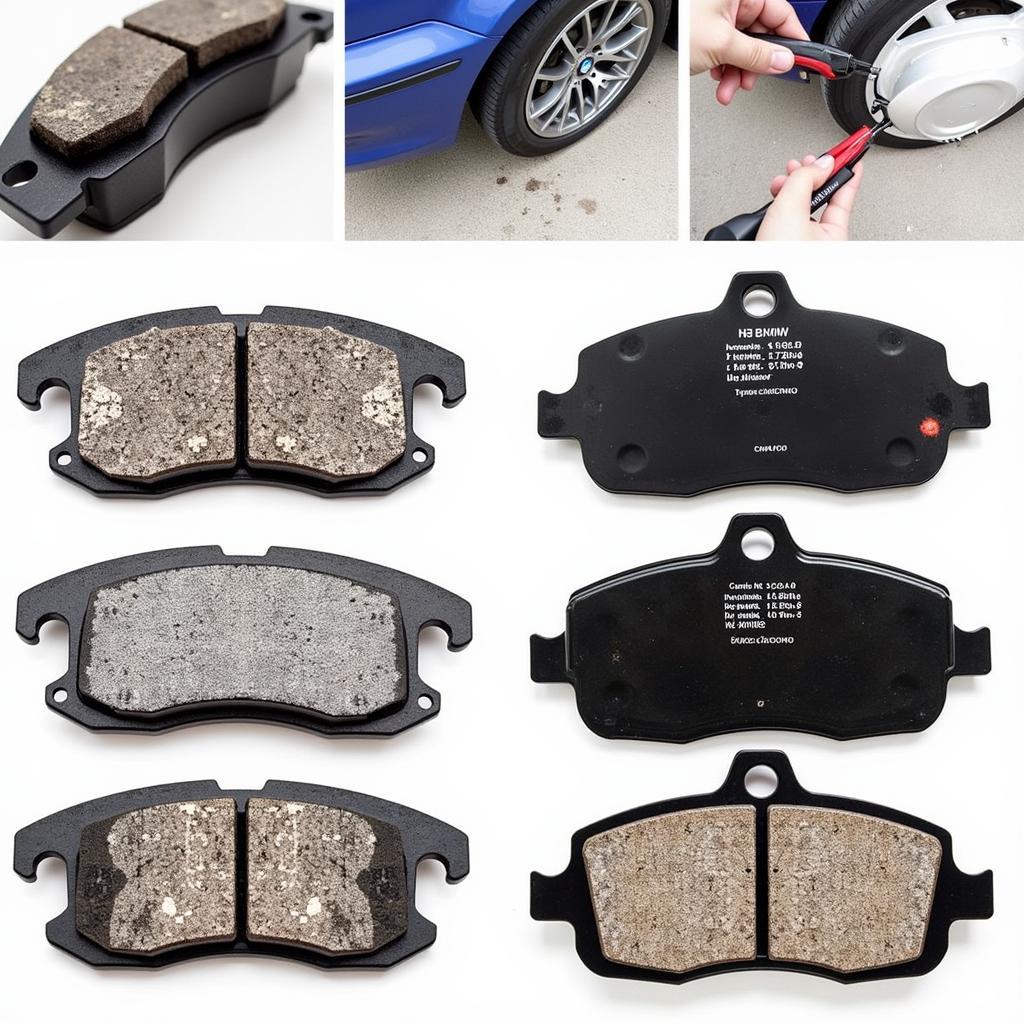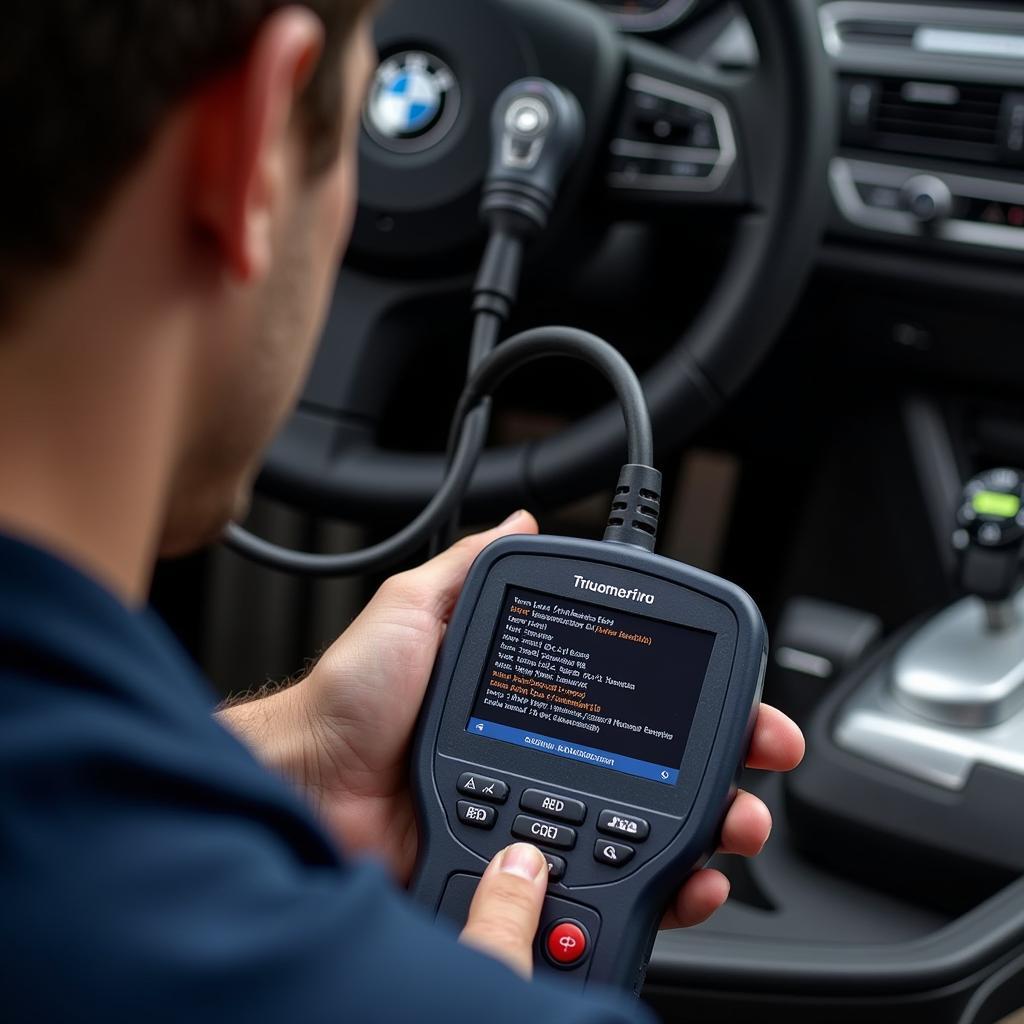A yellow brake warning light on your BMW can be unsettling. It signals a potential issue within your braking system, requiring immediate attention. This article will explore the common causes, diagnostic procedures, and solutions for this warning light, empowering you to address the problem effectively.
The yellow brake warning light, unlike its red counterpart, doesn’t always indicate an immediate emergency. However, it should never be ignored. It’s a crucial warning sign that something isn’t right and requires investigation. Ignoring it could lead to more serious and costly repairs down the line. For specific models, you might want to check resources like the bmw yellow brake light warning.
Decoding Your BMW’s Brake Warning System
BMW utilizes a sophisticated electronic brake system that constantly monitors various components. The yellow brake warning light serves as a general indicator, highlighting potential problems within this system. Understanding how this system works is crucial to diagnosing the root cause of the warning light.
Common Causes of the Yellow Brake Warning Light
Several issues can trigger the yellow brake warning light. These range from simple fixes like low brake fluid to more complex problems requiring professional attention. Here are some of the most common culprits:
- Low Brake Fluid: This is often the most straightforward cause. Low brake fluid levels can indicate a leak in the brake lines or worn brake pads.
- Worn Brake Pads: As brake pads wear down, the brake fluid level drops. The warning light will illuminate to alert you to replace the pads.
- Faulty Brake Pad Sensor: BMWs use sensors to monitor brake pad wear. A malfunctioning sensor can trigger the warning light even if the pads are still good.
- ABS Issues: Problems within the Anti-lock Braking System (ABS), such as a faulty wheel speed sensor, can also trigger the yellow brake light.
- Parking Brake Engaged: While seemingly obvious, sometimes the parking brake can be partially engaged, illuminating the warning light.
Diagnosing the Problem: A Step-by-Step Guide
Identifying the specific cause requires a systematic approach. Here’s a step-by-step guide to help you diagnose the issue:
- Check the Parking Brake: Ensure the parking brake is fully disengaged.
- Inspect Brake Fluid Level: Locate the brake fluid reservoir and check the fluid level. If it’s low, top it off with the correct brake fluid type.
- Inspect Brake Pads: Visually inspect the brake pads through the wheel spokes. Look for significant wear. If unsure, remove the wheels for a closer inspection.
- Scan for Fault Codes: Use a diagnostic scanner to read any stored fault codes related to the braking system. These codes provide valuable clues about the specific issue.
 BMW Brake Pad Wear Inspection
BMW Brake Pad Wear Inspection
“Regular maintenance, including checking your brake fluid and inspecting your brake pads, can prevent many brake system issues,” advises John Miller, Senior Automotive Technician at Bavarian Auto Experts. “Addressing these simple tasks can save you time and money in the long run.”
Solutions and Repairs
Once you’ve identified the cause, you can address the problem accordingly:
- Low Brake Fluid: Top off the brake fluid and inspect for leaks. If leaks are present, have a qualified mechanic repair the brake lines.
- Worn Brake Pads: Replace the brake pads. This is a relatively simple DIY task for experienced individuals or can be done by a mechanic.
- Faulty Brake Pad Sensor: Replace the faulty sensor. This usually requires removing the wheel and accessing the brake caliper.
- ABS Issues: Diagnosing and repairing ABS issues often requires specialized tools and expertise. It’s recommended to consult a qualified mechanic.
You might find specific information regarding older models, such as the bmw e46 yellow brake warning light, useful. Also, if you own a 2003 540i, the bmw yellow brake warning light bmw 2003 540i guide could be beneficial.
 BMW Brake System Diagnostic Scan
BMW Brake System Diagnostic Scan
Conclusion
Addressing the yellow brake warning light promptly ensures your BMW’s braking system operates safely and efficiently. By understanding the potential causes and following the diagnostic steps outlined above, you can take the necessary action to resolve the issue. Remember, a proactive approach to maintenance and timely repairs will contribute to the longevity and safety of your BMW. Don’t ignore that yellow brake warning light; it’s your car’s way of telling you something needs attention.
“Addressing brake issues early is crucial for safety,” says Sarah Chen, Lead Diagnostic Technician at Ultimate Auto Solutions. “Ignoring warning lights can lead to more significant problems, potentially compromising braking performance.”
FAQ
- Is it safe to drive with the yellow brake warning light on? While not as urgent as a red brake light, it’s not advisable to drive extensively with the yellow warning light illuminated.
- Can I reset the yellow brake warning light myself? After addressing the underlying issue, the light should reset itself. However, a diagnostic scanner can be used to clear any stored fault codes.
- How often should I check my brake fluid? Checking your brake fluid level monthly is recommended.
- How long do brake pads typically last? Brake pad lifespan varies depending on driving habits and conditions but generally ranges from 30,000 to 70,000 miles.
- What is the difference between the yellow and red brake warning lights? The yellow light indicates a potential issue or low brake fluid, while the red light signals a critical problem requiring immediate attention.
- What should I do if the yellow brake warning light comes on and off intermittently? This could indicate a loose connection or intermittent sensor malfunction. Have a mechanic diagnose the problem.
- Can low tire pressure trigger the yellow brake warning light? No, low tire pressure will trigger a separate tire pressure monitoring system (TPMS) warning light.

